Crate Label Art


Crate labels are advertising art or decorative ephemera that illustrate our country’s vast agricultural history. As farming expanded across the US and went from sustaining small communities to supplying a nation, these paper labels sprang up, pasted onto the ends of stackable wooden shipping crates, as a critical part of advertising for a grower’s or a packing company’s produce. Crate labels, which exhibited many fantastic and colorful designs, were not meant to be saved, yet the leftover unused pieces are collected for their rarity, historical significance, and aesthetic value.

Repetition Pear crate label shows how the labels were posted on the ends of the wooden shipping crates. Label printed by Schmidt Litho Co. in Seattle, WA, circa 1940s (size 11”x 7.5”).

Diving Girl Apples crate label. Printed by Schmidt Litho Co., San Francisco, CA, circa 1920s (size 10.4”x 9.4“). The empty blue box by the diver’s feet would be filled in with the kind of apple packaged, like “Newtown Pippins” for example.
The use of these labels began on the west coast in the 1880s, in California and Washington, where growers transported their products east via the newly established transcontinental railroad routes (many even built their packing houses along the railroad tracks for easier access). No longer were the products just for local stores; they were now available to an entire country. The heavy competition in the produce market inspired growers and packing companies to display attractive and unique labels on their crates to help distinguish and promote their individual brands. Later, in the early 1900s, Florida citrus growers recognized the benefits of these labels and joined in with their inspirations.
Creative labeling was a successful marketing technique. It made recognizable products and enticed auction brokers or buyers for the grocery wholesaler distributors (mainly men) to select products that stood out from the rest. The labels, therefore, had to contain lively images that appealed to these buyers, like beautiful women, famous historical or fictional characters, provocative or amusing figures, familiar people or family members, domestic or exotic animals, vehicles, gadgets, oddities, athletics, unique scenes or landscapes, or just artistic representations of the product itself.

Waldorf Apples label (size 10”x 8.75”), circa the 1950s. The crate contained one bushel of apples (their standard unit of measure).
Sizes of the labels depended on the container size, which was based on the typical units of measure for the produce, like a bushel for apples or 4/5 of a bushel for pears, for example, leading to crate labels of about 10”x 9” for apples and around 10.5”x 7.5” for pears. California oranges and grapefruits were shipped in larger boxes than lemons, so their labels were larger – box endplates were 11”x 10” for the larger citrus fruits and 11”x 9” for the smaller ones. Florida citrus packers used a different crate with an indented end, which took 9”x 9” labels. For more fragile produce like grapes, cherries, avocados, etc., a flatter, more elongated crate, or “lug box” was used; therefore, the labels were of a shorter height and were more elongated rectangles (about 13”x 3.75”). Vegetable labels were of assorted sizes but often rectangular with shorter length than height (7”x 9” was a common size). A trapezoidal-shaped box was used for asparagus due to the vegetable’s tapered stalks, and the labels also had a trapezoidal shape.

Camel pears label (size 10.25″x 7.5″). The crate contained 4/5 bushel of pears (their standard unit of measure).

Royal Knight orange crate label, litho printer unknown, circa 1920s to 1930s (size 11”x 10”). Royal Knight became a registered trademark in 1926 for the Redlands Co-operative Fruit Association, but the Royal Knight brand name was used for Sunkist oranges at least as far back as the early 1910s.
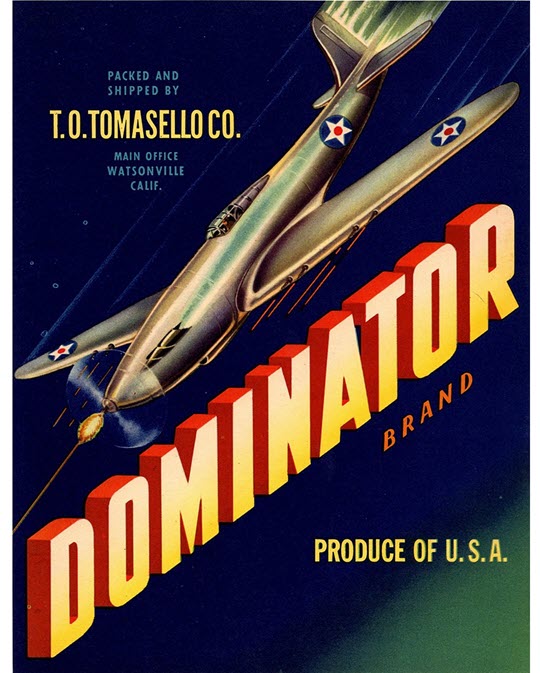
Dominator vegetable crate label, litho printer unknown, circa 1940s (size 7”x 9”). The T.O. Tomasello Co. shipped produce such as tomatoes and celery. The fictional WWII fighter plane (with a gun in the propeller?) shows the white star of the U.S. Army Air Corp with a red circle centered in it – this circle was eliminated in May 1942 to avoid confusion with Japanese aircraft.

Valley Queen grapes lug box label, litho by Stecher-Traung in San Francisco, CA, circa the 1930s-40’s (size 13″x 4″).

Maggio asparagus label, litho by Louis Roesch Co., San Francisco, CA. Trapezoidal shape (size 8.25” & 10″x 8.5″).

Blue Goose crate label (produce grown by Bella Vista Fruit Farms) circa the 1940s (size 9.75”x 8”). American Fruit Growers Association labels used orange and blue inks.
Crate labels were typically printed using a lithography process with inks of light blue, yellow, red, pink, and dark blue (some had many more colors). American Fruit Growers Association labels generally used orange and dark blue inks. Background label colors (especially in the case of citrus fruits or apples) often indicated the grade (based on size, color, and shape) of the product – blue background for the highest grade, followed by red for the medium grade, then green, yellow, brown, or white for lower grades.
Numerous lithography companies were used to mass-produce the labels. Labels were made by stone lithography (pre-1920’s) or offset printing/lithography (post-1920s). Lithographers would offer generic stock labels, which could later be overprinted with the names of the growers or packers, or they would make private labels, which are mainly what I share here.
Paper crate labels remained in use up until the 1950s. World War II impacted crate-makers’ available workforce plus printers’ resources (metals) and necessitated cost-cutting. Packaging for produce was replaced with cheaper disposable cardboard that displayed text and simpler, less-refined imagery, which was printed directly on the box material.
My collection of crate labels is still in its early stage, and admittedly, I started to collect these more for the artwork than for their historical significance. They are eye-catching, as they were intended to be, and ready for framing and displaying. As a west coast resident, I typically find more labels from California or Washington, though Florida citrus fruit crate labels are also prevalent. Labels from other states (and other countries such as Spain) show up periodically.
Researching label origins does take one back through our country’s agricultural history, and it’s fun to learn about the labels and the people that used them, though it is a challenge. Online documentation is lacking, key reference books are out of print or scattered in libraries across the country, the names of the artists (and sometimes lithography companies) are unrecorded, and the dates of use are often unclear or misrepresented. A newspaper search engine subscription is key to finding information on the growers or packers. As one views these images, many (frequently unanswerable) questions come to mind: What is the story behind the picture? Why did they use this image? What does it represent? Does it tie into the area where the produce was grown, or was it just something of personal interest to the grower or packer?
Included here are several of the crate labels in my collection, grouped loosely by image type. Hopefully, you will find something among the images or ‘fun facts’ that will spark an interest in collecting some yourself.
Beautiful Women

Kreme de Koke crate label, litho by Schwabacher-Frey, circa the 1940s (size 7“x 9.5“). This brand was patented for the Salinas Growers Exchange in 1940. The image likely depicts Norwegian skater Sonja Henie; “kreme de koke” translates from Norwegian as “cooking cream.”

Plenti Grand vegetables crate label, litho by H.S. Crocker Co, circa the late 1940s-1950s (size 7“x 9“). J “Bud” Vukasovich was a grower of lettuce, strawberries, and melons in CA from the late 1940s to the late 1970s. In 1978, UFW union leader Cesar Chavez was arrested in one of the melon fields farmed by Vukasovich for violating a Supreme Court order to picket there.

This A-Plus pears label, litho printer unknown, circa the 1950s (size 10“x 8.2”), shows an attractive female Olympian. Entiat-Wenoka growers were in business from the 1930s, but Lake Entiat (planned since the late 1950s) did not exist until 1961, when the reservoir was created along the Columbia River behind the Rocky Ridge Dam. The land flooded to make Lake Entiat previously contained 5 Entiat fruit warehouses.

Glamour Girl vegetables crate label, litho by Louis Roesch Co., circa the 1940s (size 6.9“x 5.4”). Glamour Girl became a Half Moon Bay Growers Assn. registered trademark in 1945.
Historical or Fictional Characters

Washington Brand Dehydrated Apples Crate Label, litho by Schmidt Lithography Co in Seattle, WA., circa the 1920s to 1930s (size 10.25”x 10.25”). The Washington Dehydrated Food Co in Yakima, WA, received bad press in the early years, including workers’ complaints of harsh work conditions, concerns about using lead arsenate as a pesticide, and a refusal to let federal inspectors enter to inspect their plant.

State Seal apples label, litho printer unknown, circa the 1950s (size 8”x 6.5”). The Pacific Fruit and Produce Co was one of the largest wholesalers of fruits and vegetables in the US and Canada and offered profit-sharing to their employees as early as 1944.

Lincoln brand navel orange crate label, litho by Schmidt Litho. Co., Los Angeles, CA, circa 1930s (size 11”x 10”).

Uncle Sam crate label, litho printer unknown, circa 1920s (size 11”x 9”). The red background signaled these apples were fancy grade (2nd highest grade).

Lady Rowena emperor grapes lug box label, litho by Louis Roesch Co. San Francisco, CA, circa the 1950s (size 13“x 4”). The Ivanhoe Fruit Association had several brand names that referenced characters in the novel Ivanhoe, including Ivanhoe, Lady Rowena, and Robin Hood.

Lochinvar orange crate label, litho by Schmidt Litho. Co., Los Angeles, CA, circa 1940s (size 11”x 10“). The Lochinvar brand had been around from the start of the 20th century, yet the Gold Buckle Association only became formally affiliated with Sunkist in 1942. In the poem by Sir Walter Scott, Lochinvar was a gallant knight who, as shown in the image, snatched his true love (the fair Ellen) away from her bridal festival and galloped off with her before she could wed an unworthy suitor.

William Tell Apples crate label, litho printer unknown, circa the 1930s-50’s (size 9”x 8”). The connection between William Tell and apples is obvious. R.N. Barber & Co. started growing and packaging apples in 1903 in the mountains of western North Carolina and continued using the William Tell name until the demise of the orchards in 1986. The fact that lead arsenate pesticides had been used on the land for many years later created problems for people buying new homes there.
Provocative or Amusing Figures

Miracle brand crate label, litho by Western Litho Co of Los Angeles, circa the late 1920s to 1930s (size 11”x 10”). The Bradford Brothers citrus packaging plant operated in Placentia, CA, next to the railroad tracks, from 1927 to 1978. The Miracle trademark was copyrighted in 1928. The label depicts a genie from a magic lamp with an offering of three oranges (in place of three wishes?). This genie had been used before (in 1916) in a Del Monte advertisement.

Snoboy apple crate label, litho by Louis Roesch Co, San Francisco, CA, circa the 1950s (size 10.75”x 9.25”). The Snoboy brand name started in 1925 and is still in use today. Originally, the Snoboy snowman had a black top hat, and by the 1950s had changed his headgear to red earmuffs.

Pinto vegetable crate label, Litho by Stecher-Traung of San Francisco, CA, circa the 1950s (size 7”x 9”). A vaquero (cowboy from Mexico and the southwest US) rides a Pinto horse. The word vaquero is likely the origin of the Anglo word “buckaroo.”

Yakima Chief Evaporated Apples label, litho printer unknown, circa the 1930s-40s (size 8.75”x 8.75”). The Yakima Chief brand name was patented in Feb 1931 and copyrighted in Nov 1940 for the Washington Dehydrated Food Co.

Pilgrim brand label, litho printer unknown, circa the 1950s (size 13″x 4″). The Mayflower Fruit Association, which started in 1924 with a packing plant along the Southern Pacific railroad’s right-of-way, shipped grapes and other deciduous fruits. They used brand names that complemented their business name, like Mayflower, Puritan, and Pilgrim.

Jo Jo melons crate label, litho by Louis Roesch Co, San Francisco, CA, circa the 1940s (size 9”x 4”). Jo Jo melons were a cross between cantaloupes and honeydew melons.
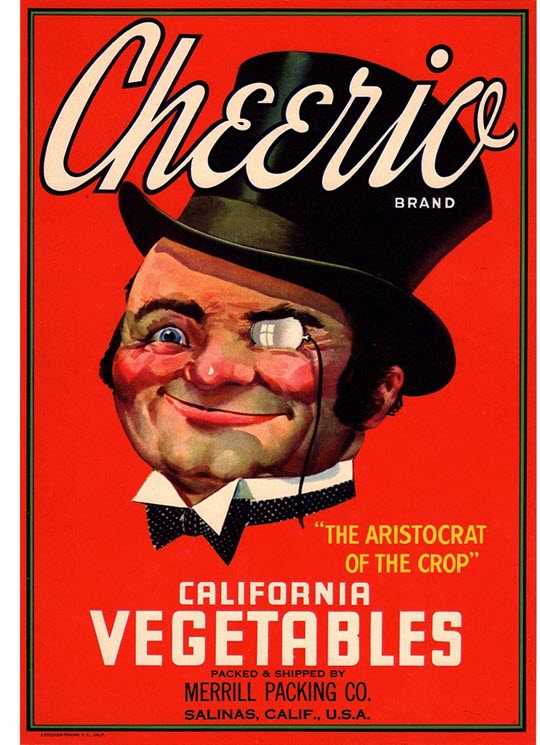
Cheerio brand vegetable crate label Litho by Stecher-Traung of San Francisco, CA, circa the 1930s (size 7”x 10”). Cheerio became a registered trademark for Merrill Packing Company in 1934. The Iceberg head lettuce label was a head of lettuce with a monocle and top hat instead of a man’s head.
Family Members and Familiar People
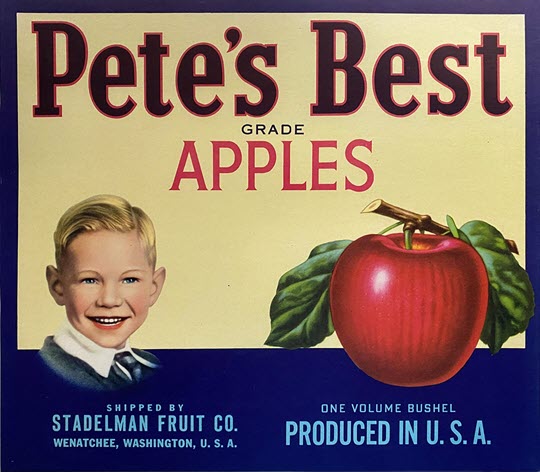
Pete’s Best apples crate label, litho printer unknown, circa the 1940s (size 10”x 8.75”). Brothers George and Wilbur Stadelman co-owned Stadelman Fruit Co. Pete Stadelman (pictured on the label) was Wilbur’s son.

Co-Ed crate label, litho printer unknown, circa the 1940s (size 11”x 10”). The College Heights Orange and Lemon Association of Claremont, CA (city of the 7 Claremont Colleges) had a series of brand names that referred to aspects of collegiate life (Co-Ed, Campus, Collegiate, Athlete, Basketball, Umpire, etc.). Brogdex was referenced because this company’s chemical treatment was used on the fruits to prevent mold growth.

Majorpak apples label shows a band leader with a saber. Litho by Stecher-Traung of San Francisco, CA, circa the 1930s (size 10.25”x 8.75”).

El-West Delite crate label, litho printer unknown, circa the 1940s (size 9”x 9”). A similar image design, of a couple dancing with two large hearts in the background and two fruits in the foreground, was used for other name brands/fruit grades that the Marion County Citrus Co. packaged, such as Hearts Delite (grade 1) and Dixie Delite (grade 2).

Aunt Jennie pomegranates crate label, litho by Louis Roesch Co, San Francisco, CA, circa the 1950s (size 11”x 4”). Joseph Slayman started Slayman Fruit Co in 1923. His sons Victor and Mitchell ran it until it was sold in 1978. The brand and label honor their mother, Jemileh (“Jennie”) Slayman.
Animals

ANACO Valencia oranges crate label, litho by Olsen Bros, San Francisco, CA, circa the 1920s (size 10.25”x 9”). The emu and kangaroo from Australia are pictured. This was an export label, as the CA citrus from ANACO (a foreign exporter operating in San Francisco) was shipped to international ports.

Mustang vegetable crate label, litho by Louis Roesch Co, San Francisco, CA, circa the 1950s (size 7”x 5”). The Western Packing Co. shipped artichokes, celery, lettuce, broccoli, endive, and cabbage to markets throughout the US and Canada.

Polar Bird lug box label, litho printer A. Carlisle & Co., circa the 1950s (size 13”x 4”). The Royal Valley Fruit Growers Association was formed in 1951 and packaged and marketed fresh fruits like grapes, plums, peaches, and nectarines. They had a cooling plant in Reedley, CA, which used ice instead of mechanical refrigeration.

Red Lion lug box label, litho printer unknown, circa the 1940s to 1950s (size 13”x 4”). John C. Kazanjian farmed grapes, and the Red Lion Packing Co became a fruit-dehydrating (raisin-drying) firm.

Elliptical-shaped King Pelican peas label, litho printer unknown, circa the 1940s to 1950s (size 8.25”x 6.6”). Frank S. and Frank E. King were father & son growers/packers. Their labels contained animals (pelican, fish) with king’s crowns. Frank E. King was also an inventor who developed a pneumatic hoe and other air-powered farming tools.
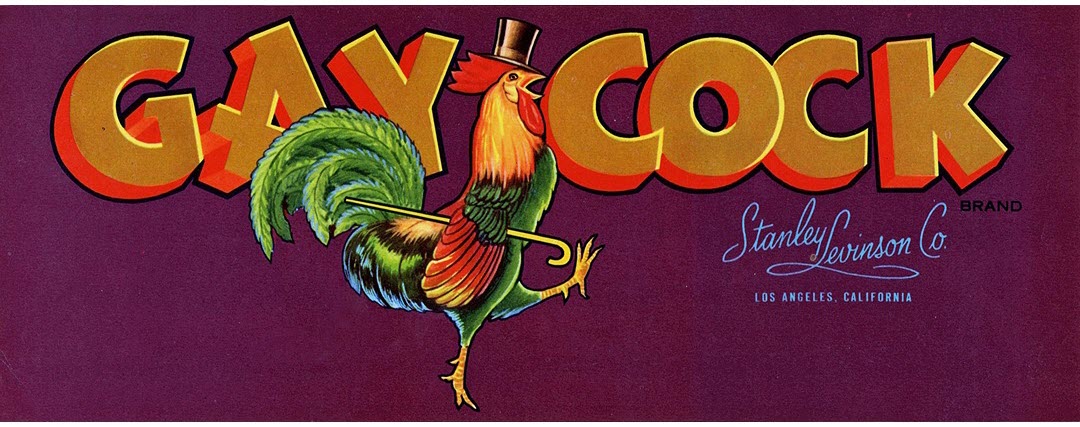
Gay Cock crate label, litho printer unknown, circa 1940s-1950s (size 11”x 4.25”). Stanley Levinson was a wholesale dealer in fruit and produce in Los Angeles. This same graphic appears in the “Head Man” brand from Stanley Levinson Co. There seems to be no clear documentation on what shipped under this label, but Levinson was a member of advisory boards for peaches and plumbs.
Scenes, Landscapes, Produce
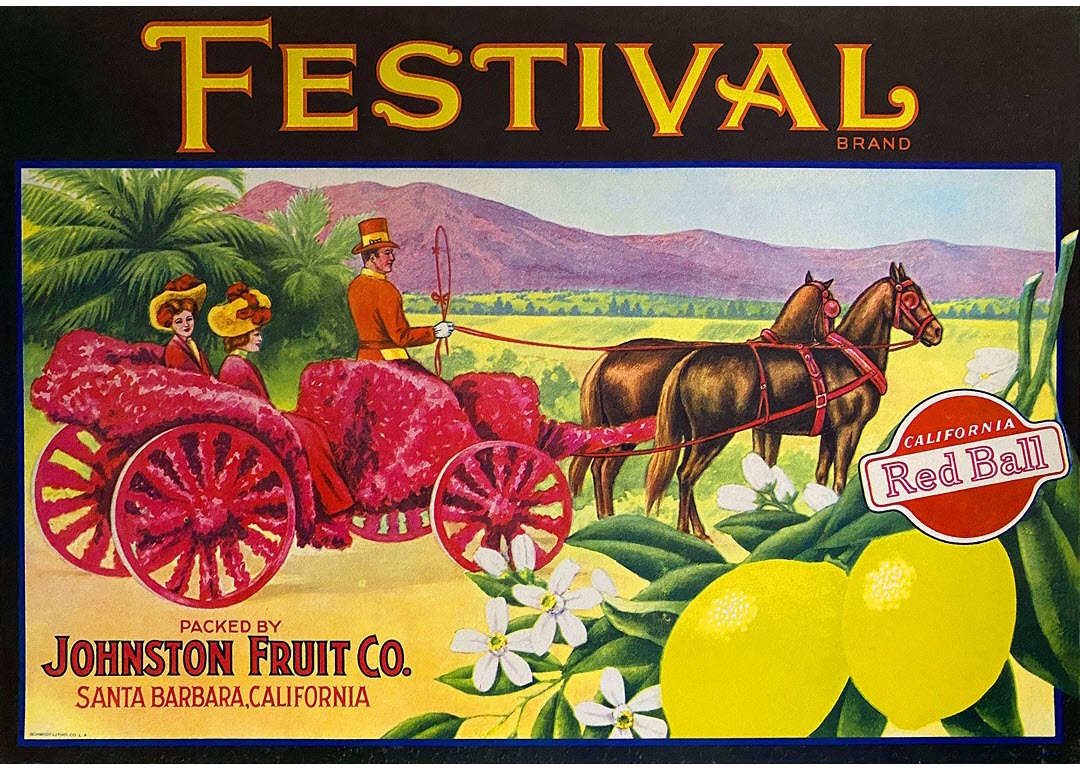
Festival brand lemons crate Label, litho by Schmidt Litho. Co., circa 1920’s (size 12.5“x 8.75“). The Festival brand name was used since 1897 but became a registered trademark in 1924. The picture, which shows a horse-drawn flower-covered carriage with riders in Victorian garb, likely commemorates the annual Santa Barbara Flower Festival (started in 1892 in honor of President Harrison’s visit to Santa Barbara), which ended in the early years of the 20th century.

Washington’s Best apple crate label. Litho by Stecher-Traung of San Francisco, CA, circa the 1940s (size 10.5”x 8.5”).

Valley View citrus crate label, litho printer unknown, circa 1930s (size 11”x 10”). This could be considered a stock label, as many different packers and brand names have used this scene of an orchard, with a hacienda, near a mountain range.
